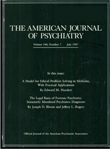REM sleep and depression: common neurobiological control mechanisms
Abstract
The author summarizes clinical data showing parallels between REM sleep and depressive phenomena; e.g., patients with endogenous depression show a first REM period that has a shorter than normal latency and a higher density of eye movement. The author discusses evidence for his hypothesis that the following commonalities in neurobiological control systems generate these parallels: 1) brainstem norepinephrine and serotonin systems suppress both REM sleep and depressive phenomena, 2) acetylcholine systems promote both REM and depressive phenomena, and 3) in control of depressive phenomena, as acetylcholine neuronal systems interact and the balance of activity between these two systems, rather than absolute activity levels in either, is the critical factor.
Access content
To read the fulltext, please use one of the options below to sign in or purchase access.- Personal login
- Institutional Login
- Sign in via OpenAthens
- Register for access
-
Please login/register if you wish to pair your device and check access availability.
Not a subscriber?
PsychiatryOnline subscription options offer access to the DSM-5 library, books, journals, CME, and patient resources. This all-in-one virtual library provides psychiatrists and mental health professionals with key resources for diagnosis, treatment, research, and professional development.
Need more help? PsychiatryOnline Customer Service may be reached by emailing [email protected] or by calling 800-368-5777 (in the U.S.) or 703-907-7322 (outside the U.S.).



